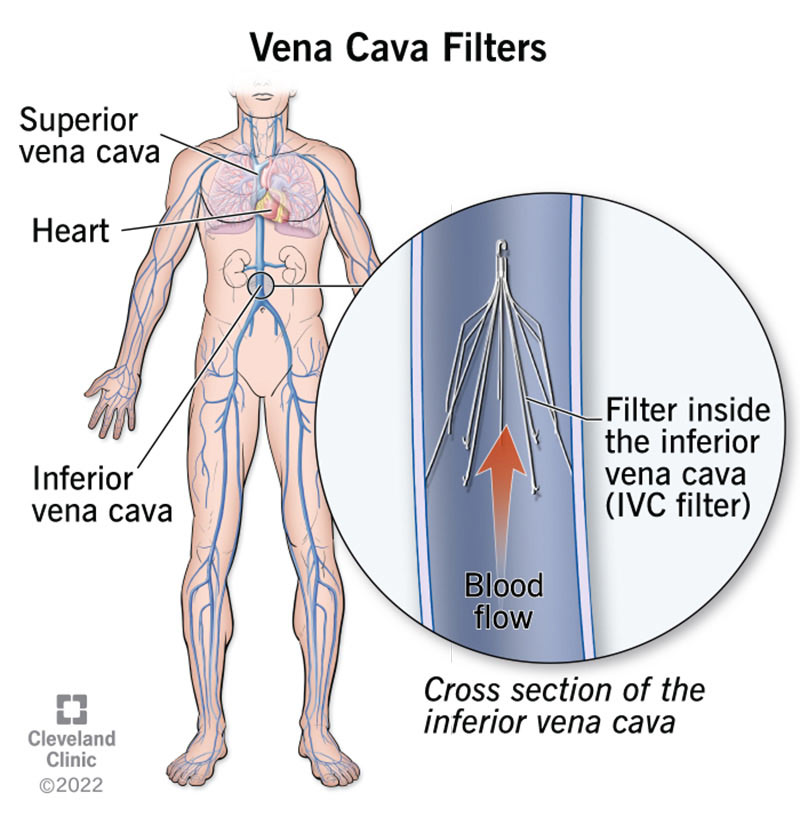Vena cava filters (IVC filters) help to prevent pulmonary embolism. Providers may suggest an IVC filter if you have blood clots and can’t take blood thinners. Filters may be permanent or retrievable. Surgeons place an IVC filter through an incision in your neck or groin. You can often return to regular activities within a day or two after surgery.

A vena cava filter is a small metal device that stops blood clots from traveling to your lungs (pulmonary embolism). Healthcare providers use two types of vena cava filter:
Healthcare providers use IVC filters much more often than SVC filters.
Cleveland Clinic is a non-profit academic medical center. Advertising on our site helps support our mission. We do not endorse non-Cleveland Clinic products or services. Policy
Your surgeon inserts the IVC filter into your inferior vena cava, a large vein in your abdomen. The inferior vena cava moves blood from your lower body to your heart. Your heart pumps this blood to your lungs to get oxygen. Blood flows through the IVC filter, but it traps any blood clots before they reach your lungs.
You may need an IVC filter if you have blood clots in your veins (venous thromboembolism or VTE) and:
Providers may recommend an IVC filter when you’re at higher risk of VTE due to:
Providers use two types of IVC filters:
Surgeons in the U.S. inserted more than 250,000 vena cava filters in 2012. Also in 2012, surgeons placed 25 times more filters in U.S. patients than in the five largest European countries combined.
Before an IVC filter placement, your provider will ask you about your health history. You’ll also need to bring in a complete medication list. You may need to stop taking some of your medications a few days before your surgery, including:
Your surgeon will give you specific instructions, including how long before your surgery to stop eating and drinking. They will usually ask you to stop eating about eight hours before surgery and to stop drinking about two hours before surgery.
To check your health before your procedure, you also may need:
Vena cava filter placement usually takes about one hour. During IVC filter placement:
After vena cava filter placement, you’ll need to recover for a few hours at the hospital. Your surgical team will monitor your heart rate and breathing. If you have pain, your healthcare providers will offer pain medication. You also may have nausea or vomiting, which shouldn’t last long.
You can usually go home the same day as your surgery. You’ll need a friend or family member to drive you home.
Surgeons can insert an IVC filter through a small incision. This means it’s minimally invasive. You don’t need major surgery to have IVC filter placement.
Providers consider vena cava filter placement generally safe. There’s a small risk that you may experience:
A vena cava filter will start working immediately. After IVC filter insertion, you may have bruising and discomfort at the catheter insertion site. Over-the-counter pain medications can help with pain relief.
Your healthcare provider will monitor your vena cava filter on a regular basis. They may suggest regular imaging tests to ensure the filter stays in the proper place.
If your surgeon inserted the IVC filter through your neck, you can usually return to your day-to-day activities within 24 hours. If your surgeon inserted it through your groin, avoid the following activities for at least 48 hours:
Your healthcare provider will offer specific guidance for your recovery.
You’ll keep a permanent vena cava filter indefinitely. But your surgeon removes an optional or retrievable vena cava filter when you:
Removing a retrievable IVC filter as soon as you no longer need it reduces your risk of complications such as:
Your surgeon will remove the retrievable IVC filter through a vein in your neck. The removal process usually takes about one hour.
Talk to your healthcare provider if you have any of these symptoms after your IVC filter surgery:
A note from Cleveland Clinic
A vena cava filter is a metal device used to prevent blood clots in your lungs (pulmonary embolism). Your surgeon guides the filter to your inferior vena cava (IVC), a large vein that transports blood from your lower body to your heart. You may get an IVC filter if you have blood clots in your veins and can’t take blood-thinning medications. The procedure usually takes about an hour. Many people return to their regular activities in one or two days. IVC filters may be permanent or temporary (retrievable). Your surgeon will need to remove a retrievable vena cava filter as soon as you don’t need it to reduce complications.
Last reviewed by a Cleveland Clinic medical professional on 03/24/2022.
Learn more about our editorial process.
Cleveland Clinic is a non-profit academic medical center. Advertising on our site helps support our mission. We do not endorse non-Cleveland Clinic products or services. Policy